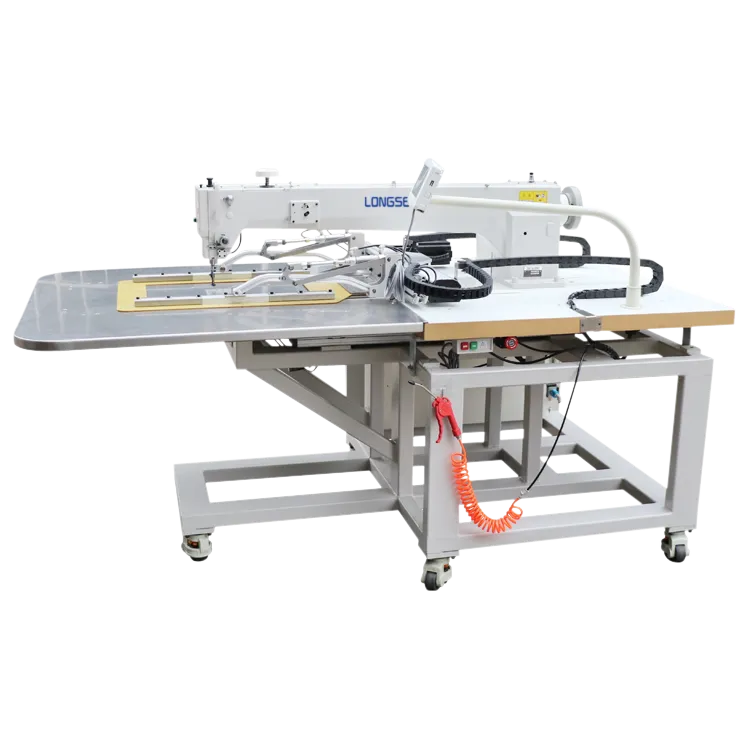high speed lockstitch machine
The High-Speed Lockstitch Machine Revolutionizing the Sewing Industry
In the realm of textile manufacturing, the lockstitch machine has long been a staple for producing high-quality seams. Among its variations, the high-speed lockstitch machine stands out as a game-changer, dramatically increasing productivity while maintaining precision. This article explores the features, benefits, and applications of high-speed lockstitch machines, highlighting their significance in modern sewing operations.
Understanding the Lockstitch Mechanism
Before delving into high-speed variations, it is essential to understand the basic lockstitch mechanism. A lockstitch machine works by interlocking two threads the needle (upper) thread and the bobbin (lower) thread. This interlocking creates a sturdy stitch suitable for a wide range of fabrics. The design and engineering of these machines allow for advanced functions and settings, enabling users to achieve professional results consistently.
Speed and Efficiency
The primary advantage of high-speed lockstitch machines is their remarkable sewing speed. These machines can sew at rates reaching up to 5,000 stitches per minute or more, depending on the model. This level of efficiency is crucial in mass production settings, where time is money. High-speed lockstitch machines significantly reduce the time it takes to complete a sewing project, allowing manufacturers to meet tight deadlines and increase output without sacrificing quality.
Quality and Precision
In addition to speed, modern high-speed lockstitch machines are designed with advanced technology that enhances stitch quality and precision. Most machines feature automatic thread tension control, which ensures consistent tension across various fabric types, preventing issues such as puckering or thread breakage. The latest models also incorporate computerized systems that allow users to program stitch types and lengths digitally, further enhancing the precision of the stitching process.
Versatility in Applications
high speed lockstitch machine

High-speed lockstitch machines are not limited to a single fabric or type of project. They are adept at handling a wide variety of textiles, ranging from lightweight materials like silk to heavier fabrics like denim and canvas. This versatility makes them an invaluable asset for clothing manufacturers, upholstery businesses, and other industries that require durable seams.
Furthermore, high-speed lockstitch machines come equipped with various features that enable specialized applications. For instance, some machines offer attachments for creating decorative stitches or safety stitching, catering to diverse customer needs. This adaptability provides businesses with the ability to expand their product lines without needing to invest in multiple types of sewing equipment.
Cost-Effectiveness
While the initial investment in a high-speed lockstitch machine may be higher than traditional sewing machines, the long-term costs can be significantly lower. The enhanced production speed and reduced labor costs help manufacturers justify the investment. Additionally, the machines' robust construction and advanced technology often result in lower maintenance costs, further contributing to their cost-effectiveness over time.
The Future of High-Speed Lockstitch Machines
As technology continues to evolve, so too do the capabilities of high-speed lockstitch machines. Innovations such as automation and artificial intelligence are gradually being integrated into machine design, promising a future where machines not only assist in sewing but also optimize processes and predict maintenance needs. This progression will likely lead to even greater efficiency and productivity in the textile industry.
Conclusion
The high-speed lockstitch machine represents a significant advancement in sewing technology, offering unparalleled speed, precision, and versatility. With their ability to boost production capacity while maintaining high stitch quality, these machines have become indispensable in various sectors of the textile industry. As manufacturers continue to seek ways to improve efficiency and reduce costs, the high-speed lockstitch machine will undoubtedly remain at the forefront of sewing technology, driving the future of textile production. Whether for small-scale operations or large factories, investing in a high-speed lockstitch machine is a step towards achieving excellence in sewing.
-
Industrial Cylinder Arm Sewing Machine: Revolutionizing Heavy-Duty SewingNewsJul.28,2025
-
Cylinder Arm Sewing Machine: Perfect for Special Sewing ApplicationsNewsJul.28,2025
-
Cylinder Bed Sewing Machine: Essential for Sewing Complex MaterialsNewsJul.28,2025
-
Heavy Duty Sewing Machine: The Essential Tool for Industrial ApplicationsNewsJul.28,2025
-
Computerized Pattern Sewing Machine: Revolutionizing Precision StitchingNewsJul.28,2025
-
Heavy Duty Industrial Sewing Machine: Power Meets PrecisionNewsJul.28,2025
-
Leather Sewing Machine: The Industrial Standard for Tough MaterialsNewsJul.18,2025





























